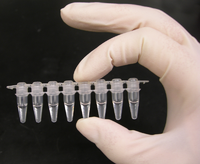
Photo from wikipedia
The LAIV currently in use is prescribed for actively immunizing individuals aged 2 to 49 years. However, it is not approved for infants and elderly individuals, who actually need it the… Click to show full abstract
The LAIV currently in use is prescribed for actively immunizing individuals aged 2 to 49 years. However, it is not approved for infants and elderly individuals, who actually need it the most, because it might prolong virus propagation and cause an apparent infection in these individuals, due to their weak immune systems. ABSTRACT RNA viruses demonstrate a vast range of variants, called quasispecies, due to error-prone replication by viral RNA-dependent RNA polymerase. Although live attenuated vaccines are effective in preventing RNA virus infection, there is a risk of reversal to virulence after their administration. To test the hypothesis that high-fidelity viral polymerase reduces the diversity of influenza virus quasispecies, resulting in inhibition of reversal of the attenuated phenotype, we first screened for a high-fidelity viral polymerase using serial virus passages under selection with a guanosine analog ribavirin. Consequently, we identified a Leu66-to-Val single amino acid mutation in polymerase basic protein 1 (PB1). The high-fidelity phenotype of PB1-L66V was confirmed using next-generation sequencing analysis and biochemical assays with the purified influenza viral polymerase. As expected, PB1-L66V showed at least two-times-lower mutation rates and decreased misincorporation rates, compared to the wild type (WT). Therefore, we next generated an attenuated PB1-L66V virus with a temperature-sensitive (ts) phenotype based on FluMist, a live attenuated influenza vaccine (LAIV) that can restrict virus propagation by ts mutations, and examined the genetic stability of the attenuated PB1-L66V virus using serial virus passages. The PB1-L66V mutation prevented reversion of the ts phenotype to the WT phenotype, suggesting that the high-fidelity viral polymerase could contribute to generating an LAIV with high genetic stability, which would not revert to the pathogenic virus. IMPORTANCE The LAIV currently in use is prescribed for actively immunizing individuals aged 2 to 49 years. However, it is not approved for infants and elderly individuals, who actually need it the most, because it might prolong virus propagation and cause an apparent infection in these individuals, due to their weak immune systems. Recently, reversion of the ts phenotype of the LAIV strain currently in use to a pathogenic virus was demonstrated in cultured cells. Thus, the generation of mutations associated with enhanced virulence in LAIV should be considered. In this study, we isolated a novel influenza virus strain with a Leu66-to-Val single amino acid mutation in PB1 that displayed a significantly higher fidelity than the WT. We generated a novel LAIV candidate strain harboring this mutation. This strain showed higher genetic stability and no ts phenotype reversion. Thus, our high-fidelity strain might be useful for the development of a safer LAIV.
Journal Title: Journal of Virology
Year Published: 2021
Link to full text (if available)
Share on Social Media: Sign Up to like & get
recommendations!